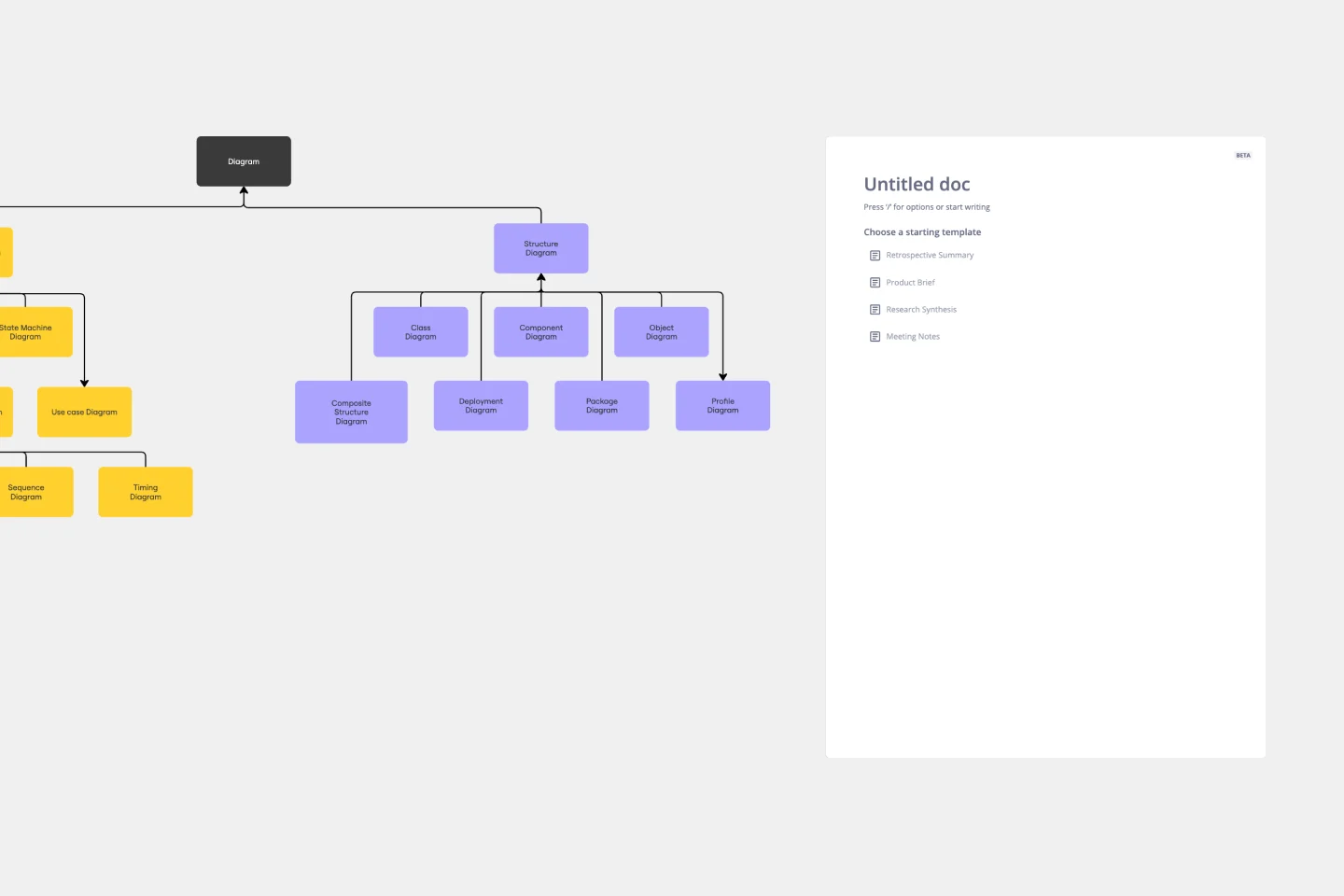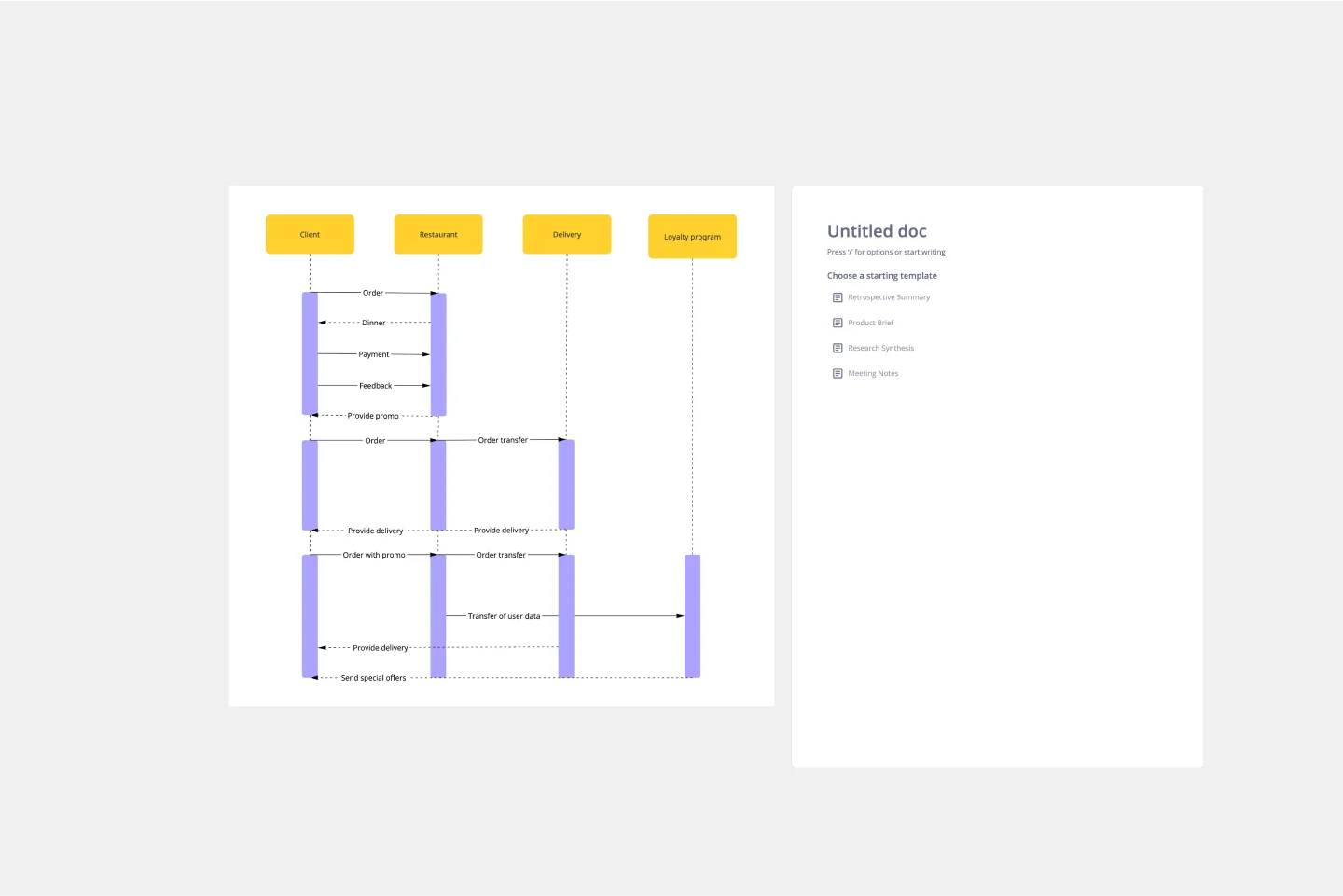About the UML Use Case Online Shopping System Template
The UML Use Case Online Shopping System Template is a tool designed to model the interactions between users (actors) and the online shopping system. It serves as a blueprint to visualize the functionalities or features of the system from the user's perspective, making it easier to understand how shoppers interact with the system to make purchases and how the system processes these requests. This template maps out the functionality and user interactions in an online shopping system, providing clarity on the shopper's journey through the system.
How to use the UML Use Case Online Shopping System Template in Miro
Customization: Once the template is added to your Miro board, you and your team can collaborate in real-time or asynchronously to customize the diagram. This involves editing the template to fit your specific requirements, such as adjusting the functionalities and interactions based on your online shopping system's unique features.
Collaboration and feedback: Miro boards update in real time, allowing your UML diagrams to become living documentation. Developers and other stakeholders can brainstorm designs together, leave feedback, and always access the latest version of the diagram.
Professional diagramming: Use Miro's features to quickly create professional UML diagrams. You can automatically generate UML diagrams with Miro AI or use UML shape packs to get started from scratch.
Why use the UML Use Case Online Shopping System Template
Using the UML Use Case Online Shopping System Template in Miro has many benefits:
Clarity: It provides a clear and standardized visual representation of the online shopping system's functionality and user interactions, making it easier for stakeholders to understand the system's design and requirements.
Efficiency: The template accelerates the documentation process, allowing teams to quickly map out and visualize the system's functionalities without starting from scratch.
Collaboration: Miro's collaborative environment enhances teamwork by enabling real-time updates and feedback, ensuring all team members are aligned and can contribute to the system's design.
Customization: The template is highly adaptable, allowing it to be tailored to the specific needs of your project. This means you can modify it to reflect the unique features and functionalities of your online shopping system, ensuring a more accurate and relevant design.
Standardization: Using the UML Use Case Online Shopping System Template promotes the use of standardized modeling languages. This not only facilitates better communication among team members but also ensures that the documentation is understandable to new stakeholders or team members who join the project at a later stage.
Problem-solving: By visualizing the interactions between users and the system, potential issues or bottlenecks can be identified early in the design process. This proactive approach allows for the resolution of problems before they become more significant, saving time and resources.
Documentation and reporting: The template serves as an essential part of the project's documentation, providing a clear and concise overview of the system's use cases. This is invaluable for reporting, future reference, and as a foundation for further development or analysis.
Educational Tool: Working with the template is an excellent educational experience for teams new to UML or system design. It helps them understand the principles of UML and how they can be applied to real-world projects, enhancing their skills and knowledge.

Miro
Your virtual workspace for innovation
Miro is an innovation workspace designed for teams of every size, everywhere, to dream, design, and build the future together. Our mission? To empower these teams to create the next big thing, powered by AI at every step of the way. Over 90 million users around the world rely on Miro to untangle complex ideas, put customer needs first, and deliver products and services faster. All supported by best-in-class security, compliance, and scalability.
Categories
Similar templates
UML Diagram Template

UML Diagram Template
Originally used as a modeling language in software engineering, UML has become a popular approach to application structures and documenting software. UML stands for Unified Modeling Language, and you can use it to model business processes and workflows. Like flowcharts, UML diagrams can provide your organization with a standardized method of mapping out step-by-step processes. They allow your team to easily view the relationships between systems and tasks. UML diagrams are an effective tool that can help you bring new employees up to speed, create documentation, organize your workplace and team, and streamline your projects.
UML Class Diagram Template

UML Class Diagram Template
Get a template for quickly building UML class diagrams in a collaborative environment. Use the UML class diagram template to design and refine conceptual systems, then let the same diagram guide your engineers as they write the code.
UML Sequence Diagram Template

UML Sequence Diagram Template
Analyze and showcase how external entities interact with your system using a sequence diagram. Get a bird’s-eye view of your work processes, business functions, and customer interactions using this diagram. Also, identify any potential problems early and solve them before implementation.
UML Diagram Template

UML Diagram Template
Originally used as a modeling language in software engineering, UML has become a popular approach to application structures and documenting software. UML stands for Unified Modeling Language, and you can use it to model business processes and workflows. Like flowcharts, UML diagrams can provide your organization with a standardized method of mapping out step-by-step processes. They allow your team to easily view the relationships between systems and tasks. UML diagrams are an effective tool that can help you bring new employees up to speed, create documentation, organize your workplace and team, and streamline your projects.
UML Class Diagram Template

UML Class Diagram Template
Get a template for quickly building UML class diagrams in a collaborative environment. Use the UML class diagram template to design and refine conceptual systems, then let the same diagram guide your engineers as they write the code.
UML Sequence Diagram Template

UML Sequence Diagram Template
Analyze and showcase how external entities interact with your system using a sequence diagram. Get a bird’s-eye view of your work processes, business functions, and customer interactions using this diagram. Also, identify any potential problems early and solve them before implementation.